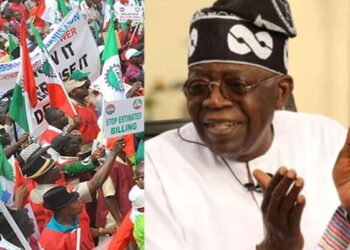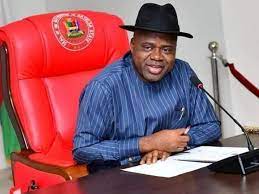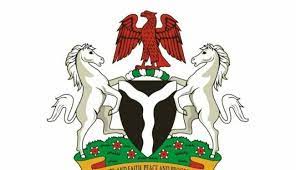The rulers of Nigeria have become so familiar with the International Monetary Fund (IMF) red flags on the country’s mounting debt that they no longer bat an eye lid over the matter. However, the warning last week that the cost of debt servicing now gulps 50 per cent of government revenue is something that should upset everyone in the federal government.
Nigeria’s national debt profile pales into insignificance when compared to that of some developing and even developed countries. Nigeria’s external debt stands at $22 billion. When the domestic debt of N5.6 trillion is added to that, it climbs to $44 billion.
That amounts to 21 per cent of Nigeria’s gross domestic product (GDP). On the contrary, the United States of America (USA), the world’s largest economy, has chalked up a national debt profile amounting to 105 per cent of its GDP. The U.S. owes $21.8 trillion against a GDP of N19.3 trillion.
Brazil is a highly industrialized economy. However, it is still a developing country. Brazil’s national debt has crossed the $2 trillion threshold and now amounts to 70 per cent of the country’s GDP.
The national debts of the U.S. and Brazil may look intimidating but the two economies are founded on solid industrial base and are deep enough to sustain the debt profile.
Besides, the cost of servicing America’s mountain of debts pales into insignificance when compared to Nigeria’s debt service bill. America borrows at anything below 1.5 per cent. Some of Nigeria’s domestic debts are incurred at a staggering 18 per cent interest rate. Even the Euro bonds issued by the federal government attract close to 300 per cent of what the U.S. pays for its debt instruments. Nigeria borrows from the international community at eight per cent.
Foreign investors see Nigeria’s debt instruments as high risk ventures but they cannot resist the high interest rate attached to the high risk. Nigeria’s debt instruments are often over-subscribed because of the attractive yield which no one could get from U.S. or German debt instruments.
Investors rush Nigeria’s debt instruments even as the IMF warns that Africa’s largest economy cannot sustain its mounting debts.
Now that the U.S. economy grows at 3.5 per cent raising fears of over-heating which the Federal Reserve Board responded by inching up lending rates, Nigeria’s foreign debt instruments might carry a yield of 10 per cent to attract the attention of foreign investors.
The problem with Nigeria’s mounting debts is that no one really sees what is being done with the proceeds. Besides, the infrastructure which the debt is reportedly used to rehabilitate simply lacks the capacity to pay back the debt.
The federal government claims to be funding railway rehabilitation with a chunk of the $11 billion it has raised in the last three years. However, the pace of rail development is agonizingly slow. Besides, the Abuja metro line which came on stream last year is running at a colossal loss. There is no way such ventures could pay back the loans raised to develop them.
Part of the debt is supposedly invested in civil aviation facilities like terminal building rehabilitation among others. Unfortunately, the cosmetic rehabilitation of airport terminals embarked upon when Stellar Odua was minister of aviation were white elephants used to divert huge sums into the purchase of armoured vehicles at inflated prices for top government officials.
Like the rail project, the rehabilitation of airport terminal buildings with expensive foreign loans just does not have the capacity to pay back the loans. Developed nations are privatising their airports.
The truth is that the projects that Nigeria borrows recklessly to finance are better funded by private investors on build-operate-and transfer basis.
Nigeria’s debt problem is worsened by the fact that the country’s economy lacks the depth to attract foreign direct investments. Two key indices portray the economy as just two shallow to attract investment. The first is the tottering capital market. The market capitalization of the Nigerian Stock Exchange (NSE) is about 10 per cent of the country’s GDP. America’s capital market is something close to 60 per cent of GDP.
The next one is the tax to GDP ratio. Nigeria’s tax revenue is less than 15 per cent of GDP. Some developed economies muster tax revenue that sail menacingly close to 40 per cent of GDP. Under current circumstances, even if Nigeria captures all the tax evaders in its tax net, the revenue would remain insignificant because of low economic productivity engendered by decaying infrastructure and high unemployment.
With debt service gulping 50 per cent of government revenue, Africa’s largest economy is sailing perilously close to fiscal calamity. The economy can no longer sustain the debt profile. If Nigeria’s debt profile rises persistently at the rate it climbed in the last three years, we would soon face a situation where debt servicing would gulp down 90 per cent of government revenue. Nothing would be left even for recurrent expenditure.
The option left for infrastructure development is private sector participation. That option could be experimented with the rehabilitation of the nation’s four ailing refineries.
If government convinces the private sector to rehabilitate the ailing refineries, it would save billions of dollars spent annually on refined petroleum products imports. It would also widen the nation’s tax base through improved economic productivity.
Blueprint gives you the latest Nigerian news in one place. Read the news behind the news on burning National issues, Kannywood, Videos and the Military



